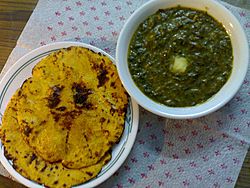Sarson ka saag facts for kids

Makki ki roti with Sarson ka saag
|
|
| Course | Main course |
|---|---|
| Place of origin | North India region of the Indian subcontinent |
| Associated national cuisine | India |
| Main ingredients | Mustard leaves |
Sarson ka saag (as it is known in Urdu/Haryanvi or Sarson da saag in Punjabi or Sareyan Da Saag in Dogri) is a popular vegetarian dish from the northern region of the Indian subcontinent. It is made from mustard greens (sarson) and spices such as ginger and garlic. It is often served with Makki ki roti. Sarson ka Saag and Makki ki Roti is closely associated with Jammu, Himachal Pradesh, Haryana and Punjab and is considered a special dish in entire North India. It is eaten especially in the winter season.
Etymology
Sarson Ka Saag literally translates to leafy vegetable preparation of mustard. The word Sarson is derived from Sanskrit word Sarśapa, the Sanskrit word for mustard. The Dogri word Sareyan is derived from the same Sanskrit root, and the word Saag is derived from Sanskrit word Śāka (Shaak) meaning greens or leafy vegetable.
Mode of serving
The dish is regarded as the traditional way to prepare saag and is usually served with Makki ki roti or Bajra ki roti or even wheat roti. It can be topped with either makkhan (butter) or more traditionally with ghee (clarified butter). Some spinach (Palak) may be added to enhance colour and thicken the dish, though this may alter the flavour.
Mustard is a winter and spring delicacy, and its relative abundance in North India has made it one of the most popular dishes in the region, as mustard has been grown in the India for millennia.
See also
 In Spanish: Sarson da saag para niños
In Spanish: Sarson da saag para niños

